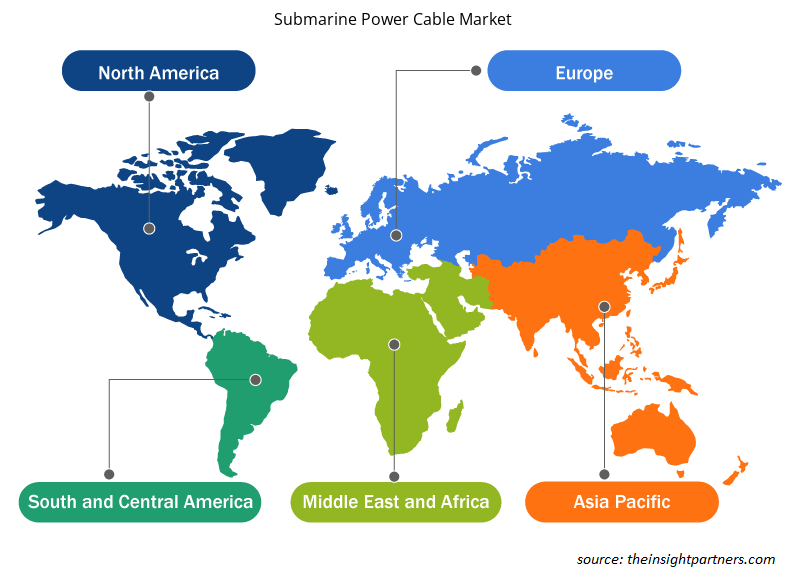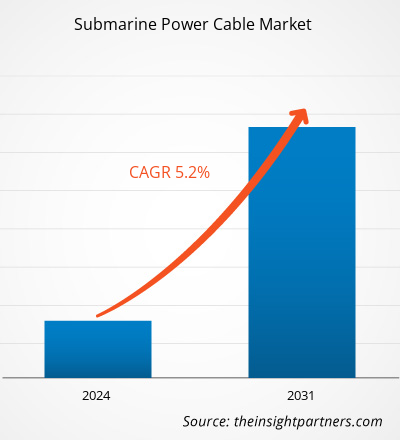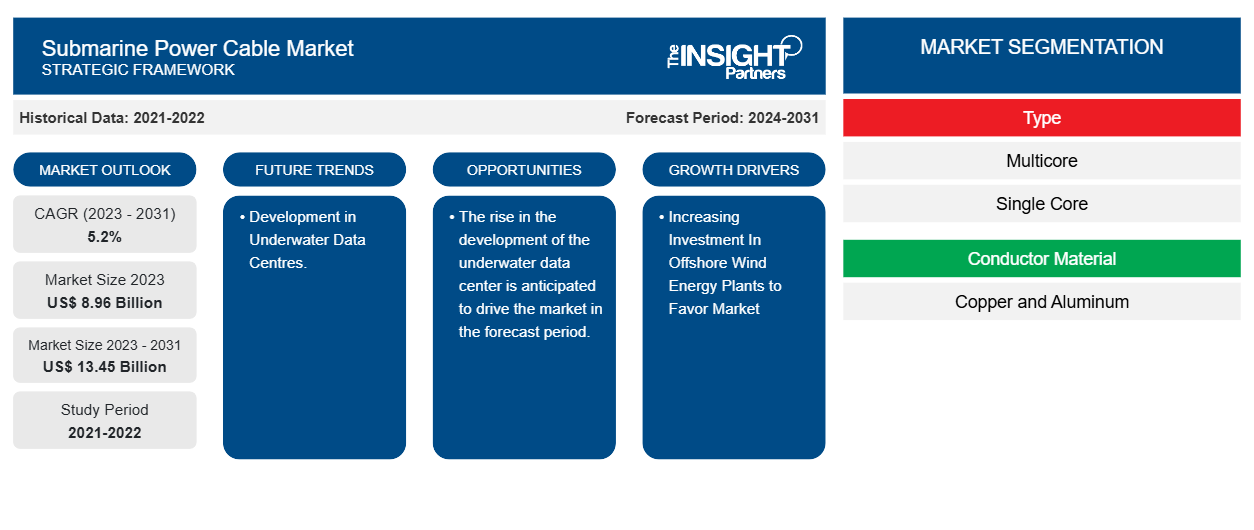Der Markt für Unterseestromkabel soll von 8,96 Milliarden US-Dollar im Jahr 2023 auf 13,45 Milliarden US-Dollar im Jahr 2031 anwachsen. Der Markt wird zwischen 2023 und 2031 voraussichtlich eine durchschnittliche jährliche Wachstumsrate von 5,2 % verzeichnen. Die steigenden Investitionen in Offshore-Windkraftanlagen und die Zunahme von länderübergreifenden Unterseeverbindungen zur Stromübertragung dürften die wichtigsten Treiber und Trends des Marktes sein.
Marktanalyse für Unterwasserstromkabel
Der Markt für Unterwasserstromkabel verzeichnet weltweit ein deutliches Wachstum. Dieses Wachstum ist auf die steigenden Investitionen in Offshore-Windkraftanlagen und die Zunahme von länderübergreifenden Unterwasserverbindungen zur Stromübertragung zurückzuführen. Darüber hinaus wird erwartet, dass die zunehmende Entwicklung von Unterwasser-Rechenzentren das Marktwachstum in den kommenden Jahren vorantreiben wird.
Marktübersicht für Unterseestromkabel
Ein Unterseekabel ist ein Übertragungskabel zur Übertragung von elektrischer Energie unter der Wasseroberfläche. Diese werden „Unterseekabel“ genannt, weil sie im Allgemeinen elektrische Energie unter Salzwasser (Meere, Meeresarme, Meerengen usw.) transportieren. Es ist jedoch auch möglich, Unterseekabel unter Süßwasser (große Seen und Flüsse) zu verwenden.
Passen Sie diesen Bericht Ihren Anforderungen an
Sie erhalten kostenlose Anpassungen an jedem Bericht, einschließlich Teilen dieses Berichts oder einer Analyse auf Länderebene, eines Excel-Datenpakets sowie tolle Angebote und Rabatte für Start-ups und Universitäten.
-
Holen Sie sich die wichtigsten Markttrends aus diesem Bericht.Dieses KOSTENLOSE Beispiel umfasst eine Datenanalyse von Markttrends bis hin zu Schätzungen und Prognosen.
Treiber und Chancen auf dem Markt für Unterwasserstromkabel
Steigende Investitionen in Offshore-Windkraftanlagen begünstigen den Markt
Die zunehmenden Investitionen in Offshore-Windenergie können den Markt für Untersee-Stromkabel erheblich ankurbeln. Die Nachfrage der Offshore-Windparks nach Infrastruktur zur Übertragung des erzeugten Stroms an Land steigt. Darüber hinaus steigt die Zahl der Offshore-Windparks im Internet. So wachsen beispielsweise die Offshore-Windparks in Europa. 2023 wurden rekordverdächtige 4,2 GW an neuen Offshore-Windparks in Betrieb genommen, ein Anstieg von 40 % im Vergleich zum Jahr 2022. Außerdem wurden neue Investitionen in Höhe von 32 Milliarden US-Dollar angekündigt, die 9 GW abdecken, die in den kommenden Jahren gebaut werden sollen. Auch die Lieferkette erlebt eine Trendwende: Neue Fabriken wurden in Dänemark, Deutschland, Polen, den Niederlanden und Spanien angekündigt.
Entwicklung von Unterwasser-Rechenzentren.
Unterwasser-Rechenzentren sind unter Wasser liegende Einrichtungen, die mit einer Strom- und Kühlinfrastruktur ausgestattet sind und Computerserver und zugehörige IT-Geräte beherbergen. Diese Einrichtungen zielen darauf ab, die Nachhaltigkeit und Effizienz von Computervorgängen zu steigern und gleichzeitig neue Grenzen in der Datenspeicher- und -verarbeitungstechnologie zu erkunden. Mehrere Länder investieren in Unterwasser-Rechenzentren. So installierte China im Dezember 2023 das Rechenzentrumsmodul von HiCloud, einer Abteilung von Highlander, 35 m tief auf dem Meeresboden vor der Küste des Kreises Lingshui Li in der Provinz Hainan. Dieses Unternehmen entwickelte das Rechenzentrum in Tests, die bis ins Jahr 2020 zurückreichen.
Segmentierungsanalyse des Marktberichts für Unterseestromkabel
Wichtige Segmente, die zur Ableitung der Marktanalyse für Unterseestromkabel beigetragen haben, sind Typ, Leitermaterial, Spannung und Anwendungen.
- Basierend auf dem Typ wird der Markt für Unterseestromkabel in Multicore- und Singlecore-Kabel unterteilt. Das Segment der Multicore-Komponenten dürfte im Prognosezeitraum einen erheblichen Marktanteil halten.multicore and single-core. The multicore components segment is anticipated to hold a significant market share in the forecast period.
- Basierend auf dem Leitermaterial ist der Markt für Unterseestromkabel in Kupfer und Aluminium unterteilt. Es wird erwartet, dass das Kupfersegment im Prognosezeitraum einen erheblichen Marktanteil halten wird.
- Nach Spannung ist der Markt in Hochspannung und Mittelspannung segmentiert. Es wird erwartet, dass das Hochspannungssegment im Prognosezeitraum einen erheblichen Marktanteil halten wird.
- Nach Anwendung ist der Markt in Offshore-Öl und -Gas, Offshore-Windkraft sowie zwischenstaatliche und Inselverbindungen segmentiert. Das Segment Offshore-Öl und -Gas dürfte im Prognosezeitraum einen erheblichen Marktanteil halten.
Marktanteilsanalyse für Unterseestromkabel nach geografischer Lage
Der geografische Umfang des Marktberichts für Unterseestromkabel ist hauptsächlich in fünf Regionen unterteilt: Nordamerika, Asien-Pazifik, Europa, Naher Osten und Afrika sowie Süd- und Mittelamerika.
Nordamerika dominiert den Markt für Unterseestromkabel. Der Trend zur Einführung hochtechnologischer Technologien in verschiedenen Branchen in Nordamerika hat das Wachstum des Marktes für Unterseestromkabel vorangetrieben. Faktoren wie die zunehmende Einführung digitaler Tools und hohe Technologieausgaben von Regierungsbehörden dürften das Wachstum des nordamerikanischen Marktes für Unterseestromkabel vorantreiben. Auch die zunehmenden Investitionen in Offshore-Windkraftanlagen und die Zunahme länderübergreifender Unterseeverbindungen zur Stromübertragung. Darüber hinaus zwingt eine starke Betonung von Forschung und Entwicklung in den entwickelten Volkswirtschaften der USA und Kanadas die nordamerikanischen Akteure dazu, technologisch fortschrittliche Lösungen auf den Markt zu bringen. Darüber hinaus gibt es in den USA eine große Anzahl von Akteuren auf dem Markt für Unterseestromkabel, die sich zunehmend auf die Entwicklung innovativer Lösungen konzentrieren. All diese Faktoren tragen zum Wachstum des Marktes für Unterseestromkabel in der Region bei.
Regionale Einblicke in den Markt für Unterseestromkabel
Die regionalen Trends und Faktoren, die den Markt für Unterwasserstromkabel während des gesamten Prognosezeitraums beeinflussen, wurden von den Analysten von Insight Partners ausführlich erläutert. In diesem Abschnitt werden auch die Marktsegmente und die Geografie für Unterwasserstromkabel in Nordamerika, Europa, im asiatisch-pazifischen Raum, im Nahen Osten und Afrika sowie in Süd- und Mittelamerika erörtert.

- Erhalten Sie regionale Daten zum Markt für Unterwasserstromkabel
Umfang des Marktberichts über Unterseestromkabel
| Berichtsattribut | Details |
|---|---|
| Marktgröße im Jahr 2023 | 8,96 Milliarden US-Dollar |
| Marktgröße bis 2031 | 13,45 Milliarden US-Dollar |
| Globale CAGR (2023 - 2031) | 5,2 % |
| Historische Daten | 2021-2022 |
| Prognosezeitraum | 2024–2031 |
| Abgedeckte Segmente |
Nach Typ
|
| Abgedeckte Regionen und Länder |
Nordamerika
|
| Marktführer und wichtige Unternehmensprofile |
|
Marktteilnehmerdichte für Unterwasserstromkabel: Auswirkungen auf die Geschäftsdynamik verstehen
Der Markt für Unterwasserstromkabel wächst rasant, angetrieben durch die steigende Nachfrage der Endnutzer aufgrund von Faktoren wie sich entwickelnden Verbraucherpräferenzen, technologischen Fortschritten und einem größeren Bewusstsein für die Vorteile des Produkts. Mit steigender Nachfrage erweitern Unternehmen ihr Angebot, entwickeln Innovationen, um die Bedürfnisse der Verbraucher zu erfüllen, und nutzen neue Trends, was das Marktwachstum weiter ankurbelt.
Die Marktteilnehmerdichte bezieht sich auf die Verteilung der Firmen oder Unternehmen, die in einem bestimmten Markt oder einer bestimmten Branche tätig sind. Sie gibt an, wie viele Wettbewerber (Marktteilnehmer) in einem bestimmten Marktraum im Verhältnis zu seiner Größe oder seinem gesamten Marktwert präsent sind.
Die wichtigsten auf dem Markt für Unterseestromkabel tätigen Unternehmen sind:
- Prysmian-Gruppe
- NKT A/S
- Sumitomo Electric Industries Ltd
- FURUKAWA ELECTRIC CO. LTD
- HENGTONG GROUP CO. LTD
- KEI Industries Limited
Haftungsausschluss : Die oben aufgeführten Unternehmen sind nicht in einer bestimmten Reihenfolge aufgeführt.

- Überblick über die wichtigsten Akteure auf dem Markt für Untersee-Stromkabel
Nachrichten und aktuelle Entwicklungen zum Markt für Unterseestromkabel
Der Markt für Unterseestromkabel wird durch die Erhebung qualitativer und quantitativer Daten nach Primär- und Sekundärforschung bewertet, die wichtige Unternehmensveröffentlichungen, Verbandsdaten und Datenbanken umfasst. Nachfolgend sind einige der Entwicklungen auf dem Markt für Unterseestromkabel aufgeführt:
- LS GreenLink USA, Inc., eine hundertprozentige Tochtergesellschaft von LS Cable & System Ltd. („LS C&S“), hat für seine neue hochmoderne Produktionsanlage für Unterseestromkabel ein 98 Acre großes Brachland in Chesapeake, Virginia, ausgewählt. Dieser strategisch günstig gelegene Standort innerhalb des Hampton Roads Beltway entlang des Elizabeth River wird LS GreenLinks Fähigkeit verbessern, die weltweite Nachfrage nach Unterseestromkabeln zu decken. (Quelle: LS GreenLink USA, Inc., Unternehmenswebsite, Juli 2024)
- Sumitomo Electric Industries, Ltd. erhielt den Auftrag zur Lieferung eines 132-kV-Seestromkabels für den Offshore-Windpark Gwynt y Môr, der etwa 15 km vor der Nordküste von Wales liegt. (Quelle: Unternehmenswebsite von Sumitomo Electric Industries, Ltd, Mai 2024)
Marktbericht zu Unterseestromkabeln – Umfang und Ergebnisse
Der Bericht „Marktgröße und Prognose für Unterseestromkabel (2021–2031)“ bietet eine detaillierte Analyse des Marktes, die die folgenden Bereiche abdeckt:
- Größe und Prognose von Unterseestromkabeln auf globaler, regionaler und Länderebene für alle wichtigen Marktsegmente, die im Rahmen des Projekts abgedeckt sind
- Trends bei Unterwasserstromkabeln sowie Marktdynamiken wie Treiber, Einschränkungen und wichtige Chancen
- Detaillierte PEST/Porters Five Forces- und SWOT-Analyse
- Analyse von Untersee-Stromkabeln, die wichtige Markttrends, globale und regionale Rahmenbedingungen, wichtige Akteure, Vorschriften und aktuelle Marktentwicklungen umfasst
- Branchenlandschaft und Wettbewerbsanalyse, die die Marktkonzentration, Heatmap-Analyse, prominente Akteure und aktuelle Entwicklungen für den Markt für Unterseestromkabel umfasst
- Detaillierte Firmenprofile
- Historische Analyse (2 Jahre), Basisjahr, Prognose (7 Jahre) mit CAGR
- PEST- und SWOT-Analyse
- Marktgröße Wert/Volumen – Global, Regional, Land
- Branchen- und Wettbewerbslandschaft
- Excel-Datensatz
Aktuelle Berichte
Verwandte Berichte
Erfahrungsberichte
Grund zum Kauf
- Fundierte Entscheidungsfindung
- Marktdynamik verstehen
- Wettbewerbsanalyse
- Kundeneinblicke
- Marktprognosen
- Risikominimierung
- Strategische Planung
- Investitionsbegründung
- Identifizierung neuer Märkte
- Verbesserung von Marketingstrategien
- Steigerung der Betriebseffizienz
- Anpassung an regulatorische Trends























 Kostenlose Probe anfordern für - Markt für Untersee-Stromkabel
Kostenlose Probe anfordern für - Markt für Untersee-Stromkabel